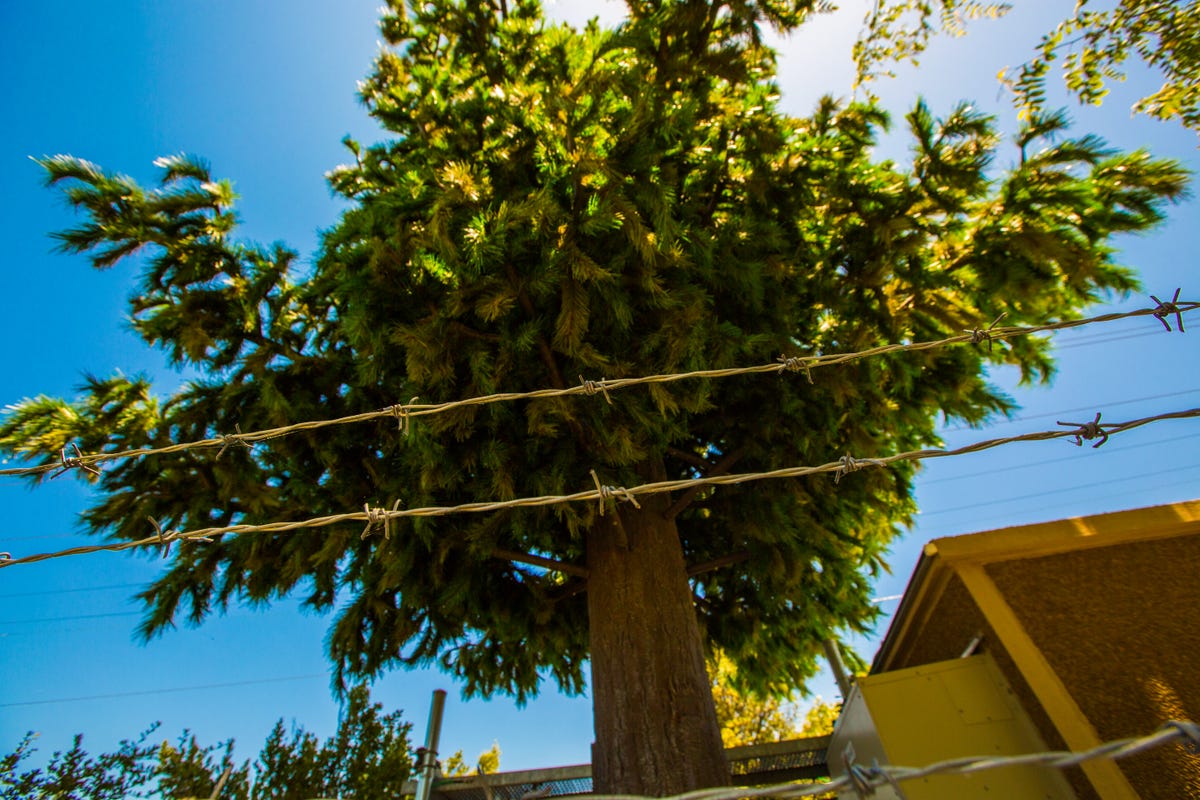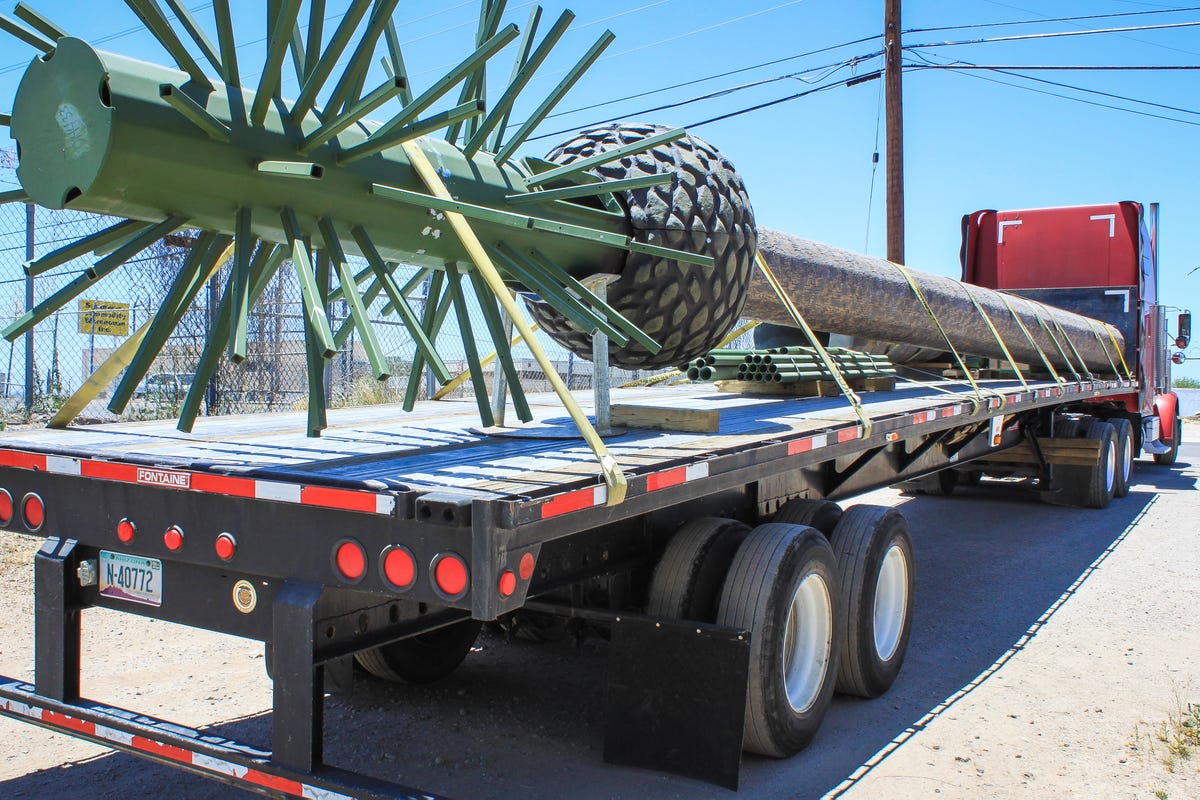 Enlarge Image
Enlarge ImageJames Martin/CNET
In Pleasanton, California, a waist-high wooden fence marks the beginning of the Iron Horse Regional Trail, a serene pathway popular with joggers and bikers.
Eight hundred feet down the path stands a lush, lone pine tree, odd in its solitude. Look closer and you’ll notice more peculiarities: The tree towers 50 feet tall, its rigid branches don’t sway with the wind and its deep emerald needles stand out from the drier, paler green foliage growing below.
This tree isn’t a tree at all. It’s a cell site tower that transmits and receives network data, call reception and GPS radio waves to the tens of thousands of residents who live close by. At its top, antennas beam out signals, and a base station the size of a backyard storage shed sits on the ground beside the “tree.” Usually the base station hums as quietly as a refrigerator, though at times it rumbles as loudly as an idling car engine.
Carrier and the city
Owned by carrier AT&T, this tower is one of 300,000 cell sites around the US, according to the CTIA’s 2013 annual wireless industry survey. Laid bare, these sites look like public eyesores that local governments are reluctant to approve. To increase their chances of installation, carriers often disguise their sites as trees, flagpoles, church steeples and lamp posts to better match their surroundings.
Even when the towers are concealed, getting permission can be an arduous process. Depending on the town, carriers run into a labyrinth of standards and rules. San Francisco, for instance, doesn’t prefer tree towers — they don’t blend with the urban setting — and has yet to install any (although Verizon is currently proposing one). And in a city known for its diversity and scenery, one disguise does not fit all.

 Enlarge Image
Enlarge ImageJames Martin/CNET
“We’re a city of neighborhoods,” says San Francisco wireless planner Omar Masry. For example, a fake water tank, he says, won’t work in the Russian Hill neighborhood, but it could work in the more industrial Bayview area. “It’s all about context.”
In general, however, many of the city’s 1,033 cell sites sit on top of buildings or are concealed as part of the building structure itself.
“The building code for San Francisco and its process is one of the most challenging jurisdictions in the entire country,” says Alba Barber, Sprint’s market manager for the city and the Bay Area.

 Enlarge Image
Enlarge ImageIn addition to the many historic buildings it wants to preserve, San Francisco requires carriers to retrofit structures they want to use for structural and earthquake integrity. Sites that involve landscaping require maintenance for upkeep, adhere to rules relating to the statewide drought, and must contain only fire retardant materials. And it all needs to be kept tidy.
“It’s amazing how all these little things make a difference for how noticeable a site is,” Masry says. “Like the cabling not being painted, or flashing lights or different ways the mounting equipment can be distracting.”
But it’s not just San Francisco that has strict regulations. Because federal law requires the American flag to be “properly illuminated during the hours of darkness,” for example, carriers must provide lighting for their flagpole cell sites if there is no one available to manually remove the flag before sunset.
Artificial trees come with their own challenges, like blending in with the scenery,so special care goes into their design. Done poorly, a tree tower can mar a once beautiful landscape. But if done well, you’d hardly know it’s there.
Designing the invisible
Crafting these massive objects, which would ideally go unnoticed, is the kind of paradoxical work Larson Camouflage has been perfecting for decades. Though the company went independent in 2005, it started out as a subsidiary of a larger business that designs themed environments for zoos, resorts and theme parks. To date, Larson has disguised thousands of cell sites, including the pine in Pleasanton.
Located in Tucson, Arizona, Larson employs roughly 20 people and operates out of a five-acre factory that was once a steel distribution center. On a typical day, you’ll find workers welding steel pipes, embossing bark grooves on soon-to-be tree trunks or dolloping paint to color-code branch inserts for later assembly. During especially hot afternoons, pedestal fans whir away near workstations to help combat the rising 100-degree heat.
Larson’s finished products, which include street lights, steeples and faux water tanks, are installed all over the world. In the US alone, the company has 20 to 30 clients, and it has shipped camouflaged cell sites to countries in Europe, South America, Asia and the Middle East. In Saudi Arabia, Larson once drew up plans for a mosque minaret. Larson’s bestsellers are trees, specifically pine trees. Production Manager Lee Scherer says it takes six to eight weeks to complete one, depending on the order.
The process of veiling a long steel pipe to resemble a tree trunk starts with a slathering of epoxy. A durable adhesive, epoxy flexes with steel in cold and hot temperatures, contracting and expanding, respectively. Larson usually mixes its proprietary epoxy in barrel drums with a brown base color.
After workers apply a thick layer to the steel “trunk,” they begin what’s typically referred to as “texturing.” Using pads the size of placemats that are textured with deep, haphazard grooves, they imprint these mats against the epoxy. Each stamp leaves ridges that mimic tree bark markings, and the pads are dunked in buckets of acetone to rinse off the epoxy as workers move down the pipe.
The epoxy is left to dry overnight before painting begins. All done by hand, it’s a four-color process that combines red, yellow and even whitish-gray, depending on the tree being mimicked. For a saguaro cactus tower like those that pepper the desert landscape outside, deeper grooves are painted green, and each of the 10,000 fake needles is dotted one by one.

 Enlarge Image
Enlarge ImageLynn La/CNET
“There’s a lot of artistry that goes into it,” says Larson President Andrew Messing. “Our heritage comes from theming, design and art. We really take that to heart.”
Larson’s team adds imperfections, too, to make towers look realistically aged; and cacti are stylized with scars that imitate the kinds left by burrowing woodpeckers. Afterward, branches of a few finished trees are tested against 100 mph winds to ensure their endurance.
Many of Larson’s saguaros are delivered to carriers in Arizona and across the Southwest US. Elm trees are getting more popular in California; but generally, the West Coast prefers palms that feature fanned-out “fronds” concentrated at the top of the trunk, and some have an additional bulbous adornment shaped like a pineapple that is attached just below. The eastern US orders the tallest trees. Compared with the 50- or 60-foot artificial pines in the West, eastern pines reach 100 to 150 feet. And for reasons unknown to Messing, Florida is partial to flagpoles.
Once in awhile, the company receives specialty orders, like an ornate lamp post for New Orleans’ French Quarter. And recently, Pebble Beach, California, ordered trees that looked as if they’d been struck by lightning. Called a “snag pole,” these lighter-colored structures have big trunks with thicker grooves and no leaves at all.

 Enlarge Image
Enlarge ImageLynn La/CNET
On average, a disguise from Larson costs about $40,000, but can range anywhere from $25,000 to $100,000 for the towering premium pines. Because of the high price, carriers often join together to co-locate, meaning they’ll share a site to split the costs.
For example, from top to bottom on a tall pine, “you got Sprint at the top, AT&T in the middle and Verizon at the bottom,” says Christopher Brydon, Sprint’s Area director for Northern California. “We’ve all got our limbs.” Cities encourage co-locating to reduce the total number of cell sites, and many of Larson’s designs accommodate the practice.
At the end of the day, Messing says, Larson builds to the needs of its clients, whether that means extra mounts for co-location or adding other design components. But it also won’t hesitate to guide them away from anything too egregiously odd, like the time he talked a client out of requesting a two-headed palm tree.
“We’d rather not build something that we think is not going to be good for our industry,” he says. “We will not do something that looks ridiculous.”
What’s considered “ridiculous” or unacceptable, however, will always differ from one individual to the next. For Messing, it’s a two-headed palm; for a city, it may be a piece of loose cabling; and for a country, it’s an unlit flagpole. But because cell towers are so necessary in what they do, and their current technology restricts how they can look for now, no one can speak in absolutes. When keeping up a charade, compromises need to be made somewhere — even if that means a humming pine tree in the middle of an open trail.
This story appears in the fall edition of CNET Magazine. For other magazine stories, go here.





